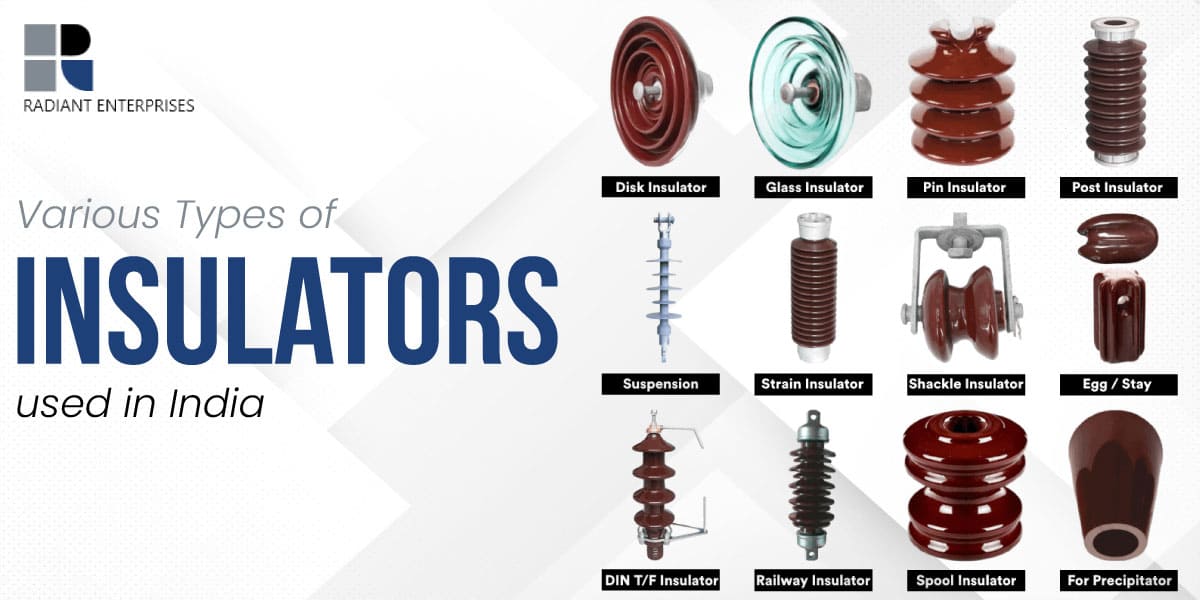
Fill all information details to consult with us to get services from us

An insulator is used to support the conductors of an overhead line on the poles, stopping the electricity from draining to the ground. It is crucial to the functioning of the transmission lines. Various materials, such as wood, rubber, mica, plastic, etc., can be used in the design of an insulator. Ceramics, glass, polymer, steatite, PVC, etc., are some of the uncommon materials found in an electrical system. The most frequent material for an insulator is porcelain, however, special compositions such as glass as well as steatite are also used. An introduction to insulators and how they function is provided here.
The following are the several categories listed by Radiant Enterprises - one of the best Insulator manufacturers in India into which these fall according to their rating: Each insulator in a transmission and distribution system uses multiple insulating discs like this. If the voltage of one disc is 11kv, the voltage of the other discs must be 66kv.
This insulator type is commonly implemented in distribution networks. This insulator can withstand voltages up to 11kV. As such, it is constructed from sturdy materials to withstand rigorous use. Both the vertical and horizontal orientations of these connections are included. There is less wear and tear on this insulator because of its straightforward design.
Designing these insulators, which are also known as disc insulators, is possible with glass or porcelain-like materials. The suspension insulator can withstand voltages between 11 kilovolts and 765 kilovolts. As a result of its greater adaptability, it finds employment in transmission lines that run above ground. To adjust the voltage, different discs are used. Because of its connection to the steel tower, it requires additional height to accommodate the discs. Radiant Enterprises is one of the most prominent Support Insulator manufacturers in India that can fulfil your Insulator requirements.
The best feature of these insulators is that even if one of the discs is broken, the others will continue to function normally, making them superior to other types of insulators. Thus, a new disc can be used in lieu of the damaged one.
Because of its employment in the transmission system located overhead, this is comparable to suspension-type insulators, but its specifications and operation are slightly different. The strain insulator can withstand voltages up to 33kV. Most of the time on a transmission line, it will be located at a bend, but sometimes it will be in an arm.
Tiny in stature, these insulators find their place in overhead power distribution. This insulator can be connected with a metal strip. This insulator can handle voltages up to 33 kV and can be used in either a bending or a bending plus a-turning configuration. These insulators are utilised as strain insulators, although only in low-voltage transmission lines at the moment. The shackle insulators can be placed in either a vertical or horizontal orientation. Bolts secure these to the pole, and they're supported by cross arms.
Substations make use of these insulators since they are suitable for usage with a variety of voltages. It is vertically stacked and serves to safeguard the various connecting components, such as transformers and switchgear. These insulators have high mechanical strength.
These square insulators are utilised in transmission lines. Unlike some other varieties, these come in more manageable sizes. Between the line conductor and the earth, you can set up these insulators. These insulators serve as safeguards, preventing voltage changes caused by unexpected breakdowns. If you are looking for the most noteworthy as well as best Insulator Manufacturers in India, Radiant Enterprises is the best pick for you.
The disc insulators are made from premium raw materials and offer a low- to medium-priced alternative for less-polluted areas. These insulators' widespread adoption in transmission and distribution lines has made them household names in the industry. These insulators have many uses in transmission lines, industries, and businesses due to their high efficiency and sturdy design; they are used to insulate cables and electrical wiring, support conductors, and keep the voltage constant under heavy loads.
These weatherproof enclosures are made from fibreglass rods and polymers. In comparison to the porcelain variety, these are lightweight and effective. PTFE, silicon rubber, EPDM, and EPM are used in manufacturing Polymer insulators by Radiant Enterprises - one of the most popular Support Insulator manufacturers in India.
In the 18th century, glass insulators were first employed for telephone as well as telegraph lines, but by the 19th century, ceramic and porcelain insulators had mostly taken their place. The toughened glass was developed as a solution, and it quickly gained popularity as a result of its increased durability.
These are weather-protected porcelain rods with metal end fittings. This insulator's units are strengthened by the absence of any metal components. They can be used in either a tension or suspension setting.
For an insulator to be effective at preventing leakage current, it must have mechanical strength, dielectric strength, and insulation resistance. Materials used as insulators must be flawless and impure-free. Insulators have strong mechanical strength, dielectric strength, and insulation resistance, all of which work together to block leakage current. The ideal insulation material would be flawless and impermeable.